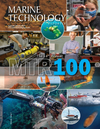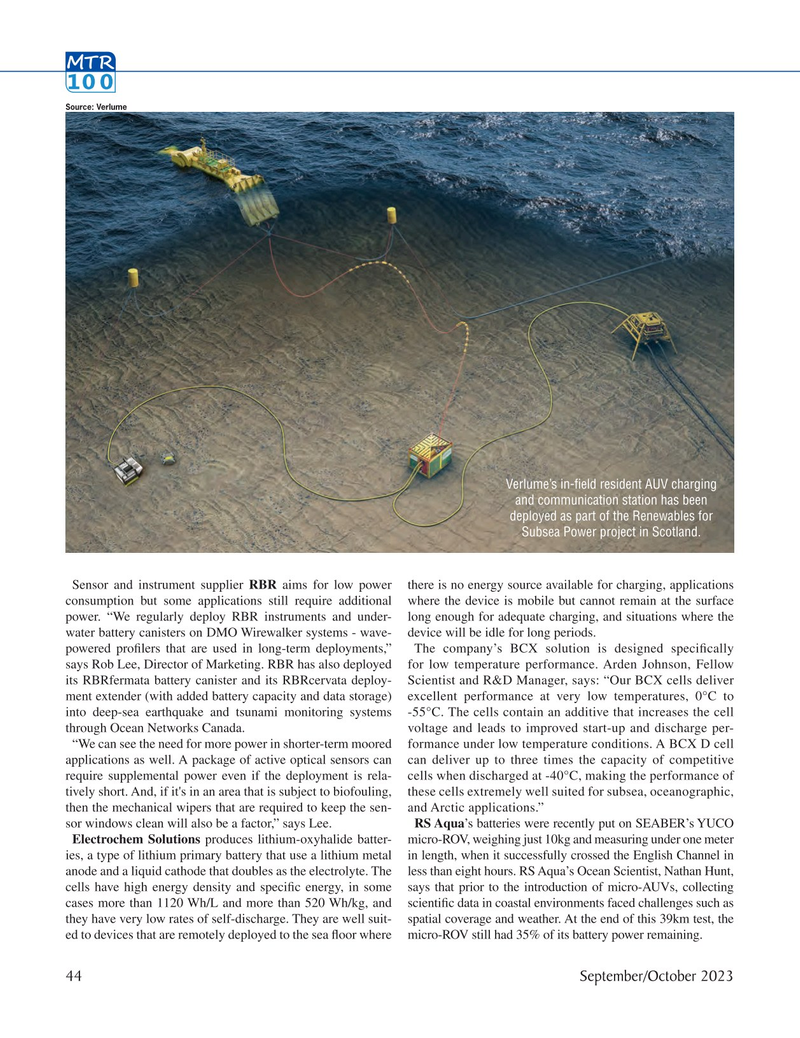
Page 44: of Marine Technology Magazine (September 2023)
Read this page in Pdf, Flash or Html5 edition of September 2023 Marine Technology Magazine
MTR 100
Source: Verlume
Verlume’s in-? eld resident AUV charging and communication station has been deployed as part of the Renewables for
Subsea Power project in Scotland.
Sensor and instrument supplier RBR aims for low power there is no energy source available for charging, applications consumption but some applications still require additional where the device is mobile but cannot remain at the surface power. “We regularly deploy RBR instruments and under- long enough for adequate charging, and situations where the water battery canisters on DMO Wirewalker systems - wave- device will be idle for long periods.
powered pro? lers that are used in long-term deployments,” The company’s BCX solution is designed speci? cally says Rob Lee, Director of Marketing. RBR has also deployed for low temperature performance. Arden Johnson, Fellow its RBRfermata battery canister and its RBRcervata deploy- Scientist and R&D Manager, says: “Our BCX cells deliver ment extender (with added battery capacity and data storage) excellent performance at very low temperatures, 0°C to into deep-sea earthquake and tsunami monitoring systems -55°C. The cells contain an additive that increases the cell through Ocean Networks Canada. voltage and leads to improved start-up and discharge per- “We can see the need for more power in shorter-term moored formance under low temperature conditions. A BCX D cell applications as well. A package of active optical sensors can can deliver up to three times the capacity of competitive require supplemental power even if the deployment is rela- cells when discharged at -40°C, making the performance of tively short. And, if it's in an area that is subject to biofouling, these cells extremely well suited for subsea, oceanographic, then the mechanical wipers that are required to keep the sen- and Arctic applications.” sor windows clean will also be a factor,” says Lee. RS Aqua’s batteries were recently put on SEABER’s YUCO
Electrochem Solutions produces lithium-oxyhalide batter- micro-ROV, weighing just 10kg and measuring under one meter ies, a type of lithium primary battery that use a lithium metal in length, when it successfully crossed the English Channel in anode and a liquid cathode that doubles as the electrolyte. The less than eight hours. RS Aqua’s Ocean Scientist, Nathan Hunt, cells have high energy density and speci? c energy, in some says that prior to the introduction of micro-AUVs, collecting cases more than 1120 Wh/L and more than 520 Wh/kg, and scienti? c data in coastal environments faced challenges such as they have very low rates of self-discharge. They are well suit- spatial coverage and weather. At the end of this 39km test, the ed to devices that are remotely deployed to the sea ? oor where micro-ROV still had 35% of its battery power remaining.
44 September/October 2023
MTR #7 (34-49).indd 44 10/2/2023 2:47:32 PM

 43
43

 45
45
